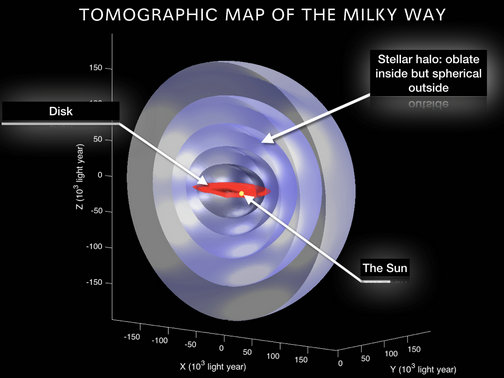A recent study discovers that the Milky Way halo has a complicated shape - it is oblate in the inner region but gradually becomes spherical in outer region.
A team of astronomers from National Astronomical Observatories of CAS (NAOC) and other institutions report that they achieve to draw an ever clearest tomographic stellar density map for the Galactic halo using 5000 red giant stars observed by LAMOST survey. The map directly shows the changing of the shape from inside to the outside. Meanwhile, the density of stars drops from inner to outer region following a power-law.
This latest observational evidence clearly rules out the previous synthesis that the Galactic halo is oblate with a double power-law-like droping stellar density profile. Theorests may have to accept the challenge from the observed astronomers and need to give a proper model to explain why the Galacrtic halo has such a complicated 3 dimensional shape.
The researchers select the tracers of the Galactic halo, 5000 red giant stars, from about 4 million stellar spectra observed by the LAMOST survey project. Although these stars is bearly more than 1% of the total number of stars, they are one of the largest samples and therefore invaluable data for the study of the Milky Way halo. Based on these data, Yan Xu, Chao Liu and her collaborators build a smart model to measure the 3 dimensional shape like to strip off an onoin. As the anonymous reviewer considered this article as “This paper is based on an important new stellar sample and the presented analysis is excellent", Monthly Notice of Royal Astronomical Society accepts it within a shorter review process and will publish it in its recent volume.

Figure: The illustration of the structure of the Milky Way halo.

Address: 20A Datun Road, Chaoyang District, Beijing, China code: 100012
Tel: 010-64888708 E-mail: naoc@nao.cas.cn

